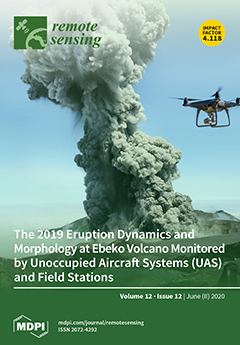From a geological standpoint, northern Pakistan is one of the most active and unstable areas in the world. As a consequence, many massive landslides have occurred in the area in historical times that have destroyed infrastructure, blocked the Hunza River, and damaged the
[...] Read more.
From a geological standpoint, northern Pakistan is one of the most active and unstable areas in the world. As a consequence, many massive landslides have occurred in the area in historical times that have destroyed infrastructure, blocked the Hunza River, and damaged the Karakoram Highway repeatedly. However, despite the high frequency of large magnitude landslide events, and the consequent damages, the entire area is largely understudied, mainly due to the difficult logistics and the large distances involved. This work is aimed at applying the potential use of Interferometric Synthetic Aperture Radar (InSAR) for landslide identification and investigation for the Hunza-Nagar Region. Sentinel-1 images covering a period of more than two years (February 2017–August 2019) were used and processed by adopting the small baseline subset (SBAS) method. The obtained deformation rate measured along the line of sight (V
LOS) varies from −114 to 20 mm/year. The downslope velocity deformation rates (V
slope) range from 0 to −300 mm/year. The V
slope stability threshold for our study area was calculated to be −14 mm/year from the V
slope standard deviation. Four active landslides with V
slope exceeding 14 mm/year were recognizable and have been confirmed by field inspection. The identified landslides listed from the most active to least active are the Humarri, Mayoon, Khai, and Ghulmet landslides, respectively. V
LOS exceeding 114 mm/year was observed in the Humarri landslide, which posed a threat of damming a lake on the Hispar River and was also a risk to the Humarri Village located below the landslide. The maximum mean deformation detected in the Ghulmet, and Mayoon landslide was in the order of 30 mm/year and 20 mm/year, respectively. More importantly, it was found that in places, the slope deformation time series showed a patchy correlation with precipitation and seismic events in the area. This may indicate a complex, and possibly uncoupled, relationship between the two controlling agents promoting the deformation. However, the collective impact of the two factors is evident in the form of a continuously descending deformation curve and clearly indicates the ground distortion. The results indicate a potentially critical situation related to the high deformation rates measured at the Humarri landslide. On this specific slope, conditions leading to a possible catastrophic failure cannot be ruled out and should be a priority for the application of mitigation measures.
Full article





